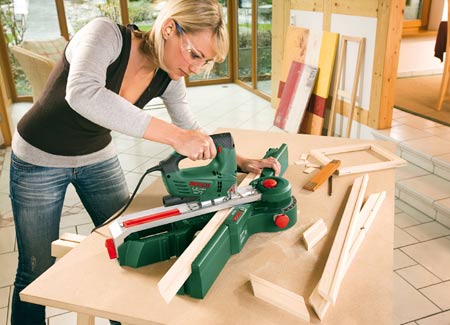Tricks for Chicks – Using a Jigsaw
Jigsaws are the perfect power tool for cutting curves and complex shapes. And once you become more confident in using a jigsaw, you will discover many ways to use this power tool for home decor and do-it-yourself projects around the home.

A jigsaw is also the perfect tool for cutting short, straight lengths of softwoods up to a thickness of 68mm. If, like me, you use Supawood or Plywood for DIY projects, get to know your Jigsaw – there are so many ways to use it.
Wood with a veneer finish
Most wood-cutting blades for jigsaws are designed so the teeth cut on the upstroke. For fine work demanding less chipping – in wood veneers, for example – an alternative is to place masking tape on the cutting line path before drawing on the pattern line. Another option is to score the veneer along the cutting line with a Stanley knife.
Cutting curves
To make smooth curves in wood, begin by pressing the base plate firmly on the workpiece with the blade away from the edge. Switch on and guide the blade along the outside of the cutting line, moving from the start of the curve to the inside corner. Don’t apply too much pressure, don’t push too hard and ensure that the blade stays vertical. If you find that the blade get stuck, make a relief cut from the outside in to remove waste pieces. As Jigsaw blades tend to bend when cutting curves in thicker boards, always use a sharp blade and avoid forcing the saw through the cut.
Straight cuts
You can easily use a jigsaw for straight, compound and bevelled cuts through timber. Hold the workpiece firmly and guide the saw steadily against a saw fence. Avoid driving blades into the bench top (bending and breaking them) by using rails to raise the work-piece.
Cutouts in laminate worktops
If you need to do cutouts in laminate worktops, to insert a kitchen sink, for example, drill a starter hole 10 or 12mm diameter that allows insertion of the jigsaw blade, and follow the cutting line drawn on masking tape. To avoid scratches on the worktop, affix masking tape to the bottom of the base plate.
Mitre cuts
For mitre cuts the base plate can be swivelled by 45 degrees to the left or right for mitre cuts. Remove the saw blade and loosen the screw in the base plate; slide the base plate towards the cable end. The base plate has adjustment notches on the left and right at 0, 22.5 and 45 degrees. Swivel the base plate to the desired position.

Choosing the right blade
A jigsaw cuts using a rapid up-and-down motion of the saw blade. The key to excellent results with a jigsaw is to match a specific blade to the type of material you will be cutting: wood, metal, plastics, etc. Always check the package labeling when buying blades.


Comments
Add comment